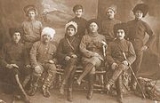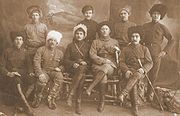
Amur Front
Encyclopedia

Far Eastern Republic
The Far Eastern Republic , sometimes called the Chita Republic, was a nominally independent state that existed from April 1920 to November 1922 in the easternmost part of the Russian Far East...
during the Russian Civil War
Russian Civil War
The Russian Civil War was a multi-party war that occurred within the former Russian Empire after the Russian provisional government collapsed to the Soviets, under the domination of the Bolshevik party. Soviet forces first assumed power in Petrograd The Russian Civil War (1917–1923) was a...
in Transbaikal
Transbaikal
Transbaikal, Trans-Baikal, Transbaikalia , or Dauria is a mountainous region to the east of or "beyond" Lake Baikal in Russia. The alternative name, Dauria, is derived from the ethnonym of the Daur people. It stretches for almost 1000 km from north to south from the Patomskoye Plateau and North...
.
It was created on April 22, 1920 on base of the partisan formations of the Eastern Transbaikal Front. Its operative area consisted of the following towns: Nerchinsk
Nerchinsk
Nerchinsk is a town and the administrative center of Nerchinsky District of Zabaykalsky Krai, Russia, located east of Lake Baikal, east of Chita, and about west of the Chinese border on the left bank of the Nercha River, above its confluence with the Shilka River, which flows into the Amur...
, Nerchinsky Zavod, Sretensk
Sretensk
Sretensk is a town and the administrative center of Sretensky District of Zabaykalsky Krai, Russia, located on the right bank of the Shilka River , east of Chita.Population: It was founded in 1689 and granted town status in 1926....
, Blagoveshchensk
Blagoveshchensk
Blagoveshchensk is a city and the administrative center of Amur Oblast, Russia. Population: -Early history of the region:The early residents of both sides of the Amur in the region of today's Blagoveshchensk were the Daurs and Duchers...
, Onon, and Khabarovsk
Khabarovsk
Khabarovsk is the largest city and the administrative center of Khabarovsk Krai, Russia. It is located some from the Chinese border. It is the second largest city in the Russian Far East, after Vladivostok. The city became the administrative center of the Far Eastern Federal District of Russia...
. The Amur Front's headquarters was in Blagoveshchensk.
The Amur Front's Makeup
- 1st Transbaikal Cavalry Corps then Division (Korotayev Yakov)
- 1st Amur Infantry Division
- 2nd Amur Infantry Division
- 1st Amur Cavalry Brigade
The Amur Front's achievements

Grigory Semyonov
Grigory Mikhaylovich Semyonov, or Semenov , was a Japanese-supported leader of the White movement in Transbaikal and beyond from December 1917 to November 1920, Lieutenant General and Ataman of Baikal Cossacks .-Biography:Semyonov was born in the Transbaikal region of eastern Siberia...
's White Cossacks and the Japanese Expeditionary Corps. The objectives of the attack were an attempt of creating the "Black Buffer" from Chita to Primorye
Primorsky Krai
Primorsky Krai , informally known as Primorye , is a federal subject of Russia . Primorsky means "maritime" in Russian, hence the region is sometimes referred to as Maritime Province or Maritime Territory. Its administrative center is in the city of Vladivostok...
and prevention of establishment of the Far Eastern Republic. After signing the Gongota Agreement
Gongota Agreement of 1920
The Gongota Agreement of 1920 was a milestone in the Russian Civil War in Transbaikal. The Agreement was finalized at Gongota railway station on July 15, 1920 between the Far Eastern Republic's delegation headed by Alexander Krasnoshchyokov and Genrich Eiche and the Japanese Expeditionary Corps...
between the Government of the Far Eastern Republic and the Japanese Expeditionary Corps, military confrontations in Transbaikal between the People's Revolutionary Army and the Japanese were over and the Amur Front launched the final operation of taking Chita on October 1, 1920. Chita was taken on October 22, 1920 and the rest of Grigory Semyonov's troops had been expelled from Transbaikal by November 1, 1920. At that time the Amur Front included 38,000 personnel, 60 field guns, 191 machine guns, 6 armored trains, 10 tanks.
On November 24, 1920 the Amur Front was reorganized into the 2nd Amur Army.
Commanders-in-Chief
- Dmitriy Shilov (April 22, 1920 to August 18, 1920)
- Semen Seryshev (August 18, 1920 to November 24, 1920)

